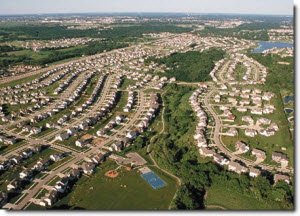Sources and Solutions
The primary sources of nitrogen and phosphorus pollution are:
- Agriculture: The nitrogen and phosphorus in animal manure and chemical fertilizers are necessary to grow crops. However, when these nutrients are not fully utilized by plants they can be lost from the farm fields and negatively impact air and downstream water quality.
- Stormwater: When precipitation falls on our cities and towns it runs across hard surfaces - like rooftops, sidewalks and roads - and carries pollutants, including nitrogen and phosphorus, into local waterways.
- Wastewater: Our sewer and septic systems are responsible for treating large quantities of waste, and these systems do not always operate properly or remove enough nitrogen and phosphorus before discharging into waterways.
- Fossil Fuels: Electric power generation, industry, transportation and agriculture have increased the amount of nitrogen in the air through use of fossil fuels.
- In and Around the Home: Fertilizers, yard and pet waste and certain soaps and detergents contain nitrogen and phosphorus, and can contribute to nutrient pollution if not properly used or disposed. The amount of hard surfaces and type of landscaping can also increase the runoff of nitrogen and phosphorus during wet weather.


